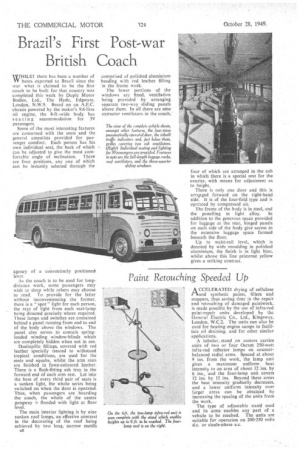Brazil's First Post-war British Coach
Page 42

If you've noticed an error in this article please click here to report it so we can fix it.
WHILST there has been a number of W buses exported to Brazil since the war what is claimed to be the first coach to be built for that country was completed this week by Duple Motor Bodies, Ltd.. The Hyde, Edgware, London, N.W.9. Based on an A.E.C. chassis powered by the maker's 9.6-litre oil engine, the 8-ft.-wide body has seating accommodation for 39 passengers.
Some of the most interesting features are concerned with the seats and the general amenities provided for passenger comfort. Each person has his own individual seat, the back of which can he adjusted to give the most com fortable angle of inclination. There are four positions, any one of which can be instantly selected through the agency of a conveniently positioned lever.
As the coach is to be used for longdistance work, some passengers may wish to sleep while others may choose to read. To provide for the latter without inconveniencing the former, there is a " spot " light for each person, the rays of light from each seat-lamp being directed precisely where required. These lamps and switches are contained behind a panel running from end to end of the body above the windows. The panel also serves to contain springloaded winding window-blinds which are completely hidden when not in use.
Dunlopillo fillings, covered with red leather specially treated to withstand tropical conditions, are used for the seats and squabs, whilst the arm rests are finished in fawn-coloured leather. There is a flush-fitting ash tray in the forward end of each arm rest. Let into the base of every third pair of seats is a sunken light, the whole series being switched on when the door is operated. Thus, when passengers are boarding the coach, the whole of the centre gangway is flooded with light at floor level.
The main interior lighting is by nine sunken roof lamps, an effective contrast in the decorating of the roof being achieved by two long, narrow motifs 148 comprised of polished aluminium beading with red leather filling in the frame work.
The lower portions of the windows are fixed, ventilation being provided by arranging separate two-way sliding panels above them. In all there are nine extractor ventilators in the coach,' four of which are arranged in the cab in which there is a special seat for the courier, with means for adjustment as to height.
There is only one door and this is arranged forward on the right-hand side. It is of the four-fold type and is operated by compressed air.
The frame of the body is in steel, and the panelling in light alloy. In addition to the generous space provided for luggage at the rear, hinged panels on each side of the body give access to the extensive luggage space formed beneath the floor.
Up to waist-rail level, which is denoted by wide moulding in polished aluminium, the finish is in light blue, whilst above this line primrose yellow gives a striking contrast.




























































































